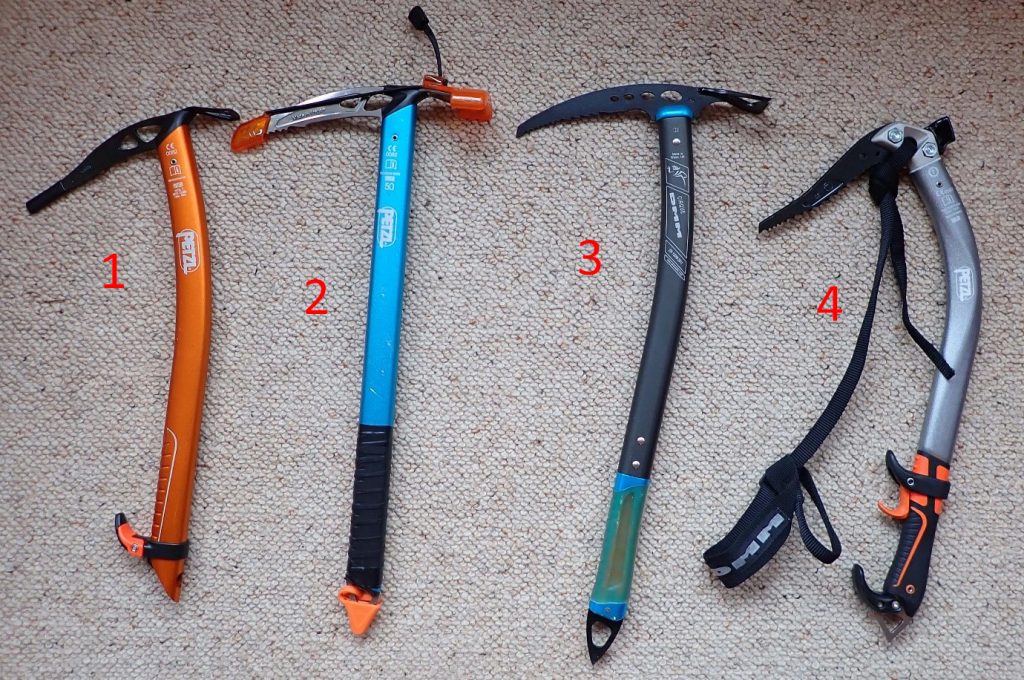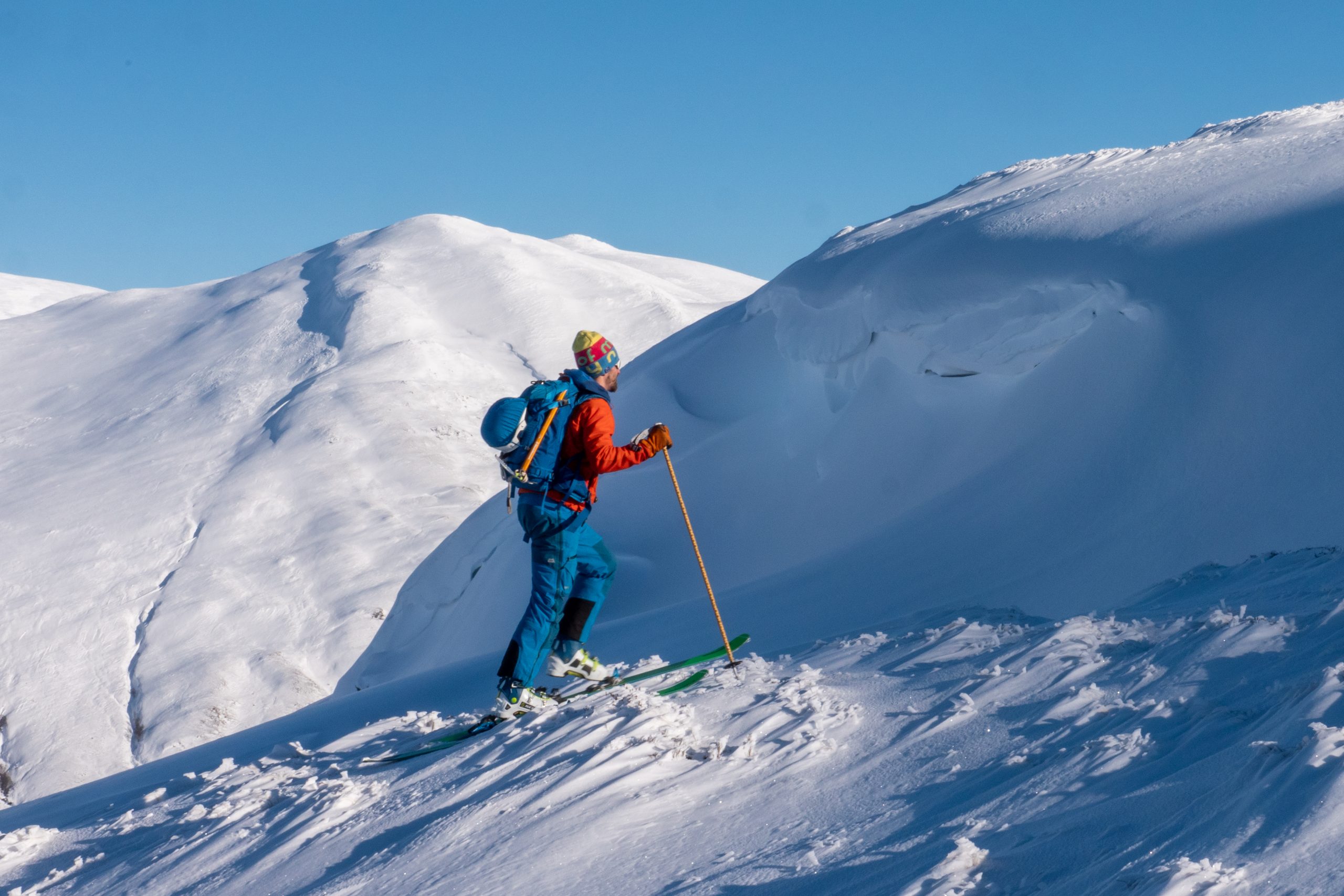Ice Axes and Backcountry Touring
Brendan Hughes
Training & Equipment officer
If your tour will take you across steep, rocky or icy ground on foot, then you will need an ice axe (and boot crampons too). They aren’t essential on more mellow tours, but even then you might want one for emergency use. And they aren’t just for deep winter – spring conditions often mean booting across short icy snow patches where a slip could be serious without an axe.
The main reason to have an axe is to prevent or arrest a slip when on foot which can otherwise become lethal slides or falls. You can also use them to chop a stance – like when you realise you need to put ski crampons on, but you’ve left it late and it’s too icy to step out the ski without risking a slip. Likewise when transitioning from skin-to-ski on a steep slope. You can also use them to chop hand and foot holds, aid climbing up steep rock and ice and to make snow anchors for use with a rope. But they are far less effective than shovels for digging out buried avalanche victims.
The best axes for ski touring should be lightweight and not too long – ideally between 45-50cm. General purpose ice-axes are heavier, but fine if you don’t mind the extra weight. Just don’t go too long – If you want a walking stick, use one of your ski poles. Some axes come with a bend in the shaft, which is good for climbing, but less effective for chopping, so straight shafts are generally better for general touring use – you will use the axe for chopping more than climbing. Ice climbing tools are best for just that and come with trigger grips, more radical bent shafts and a dropped, rather than curved, pick. There are also innovations like the ‘Shaxe’ by BCA – this uses a single shaft that can be attached to either a shovel blade or an ice axe head. It saves some weight, but if you lose your axe in the avalanche, then your shovel is also useless…

Backcountry Ice Axes: 1. Lightweight ski-mountaineering axe, 2. Lightweight ski touring/muntaineering axe, 3. General use ice axe, 4.Technical ice climbing tool
Carry it where you can get at it easily. Most packs have a dedicated loop or two to carry the axe on the outside, although these leave the spike on the bottom of the axe pointing up – this can be dangerous to people around you if the axe is long and flopping around on the bag. It is better to use the compression straps on the side, or even put it inside the pack, especially when skiing down so there is less chance of spiking yourself or someone else in a crash (which is why having a shorter axe is good). Protective covers for the pick, adze and spike will help protect the paintwork on your car and are mandatory in cable cars and trains in Switzerland, but should be removed as soon as you need to get it out.
Get it out before you need it. If you are approaching a steep gully or exposed ridge on foot, you’ll need it off your pack and in your hand well before it gets tricky. If still skinning, but where you think you might need the axe quickly (i.e. to chop a stance to get ski crampons on), you can carry the axe using a gear loop on your pack waist belt as a holster, or slide it underneath a shoulder strap between you pack and your back (far more comfortable than it sounds). Either way will let you get the axe in hand instantly without taking off your pack.
Always wear gloves or mitts when using an axe. Your skin will thank you for it. But you must still be able to grip and have firm control of the axe at all times, so gloves with a leather palm or grippy pads are better. If the axe itself doesn’t have a good grip on the shaft, this can be remedied with ‘grip tape’ sold by DMM (the blue Petzl axe in the picture has been improved with grip tape).
Have a wrist leash you can easily attach or remove. A leash will stop you losing your axe if dropped and will make both chopping and climbing with the axe easier, but they can be an annoyance when zig-zagging up a steep slope when you have to swap the axe from hand to uphill hand. Having an easily removable leash is good – keep it handy in a pocket and pop it on when needed. Sliding with an axe flailing on the end of a leash can be dangerous… but losing your axe in a slide could be fatal: you have to judge which is the greater risk to you.
Don’t be tempted to try to ski, ride or skin with an axe in your hand – you are on the wrong slope for you if that seems like a necessity! Skinning across exposed icy traverses is more challenging and the risk of a serious slip is real. Put your ski crampons on and consider getting an axe in your uphill hand. If you do this a lot, then something like the Black Diamond Whippet can be a good option. This is a pick you attach to the top of a compatible ski pole that will allow a self-arrest using the pole. But they are no real replacement for an ice axe when ski mountaineering.
Using an axe effectively needs practice. The best way to learn is go on a winter skills course. Self-arrest skills should always be refreshed at the beginning of each season as they need to be instinctive. Practice chopping steps and stances.


